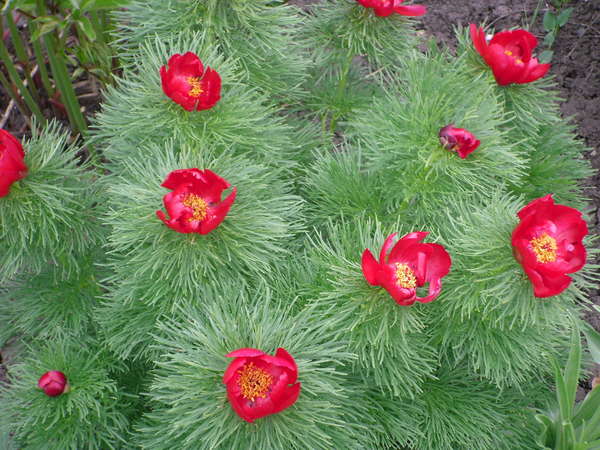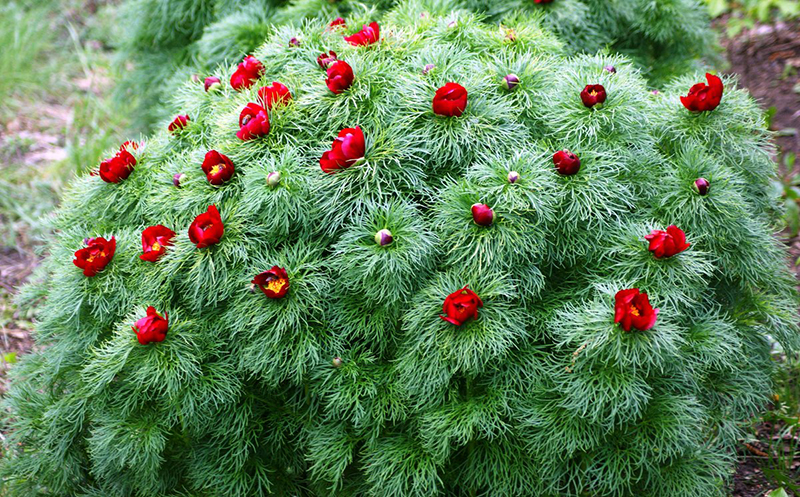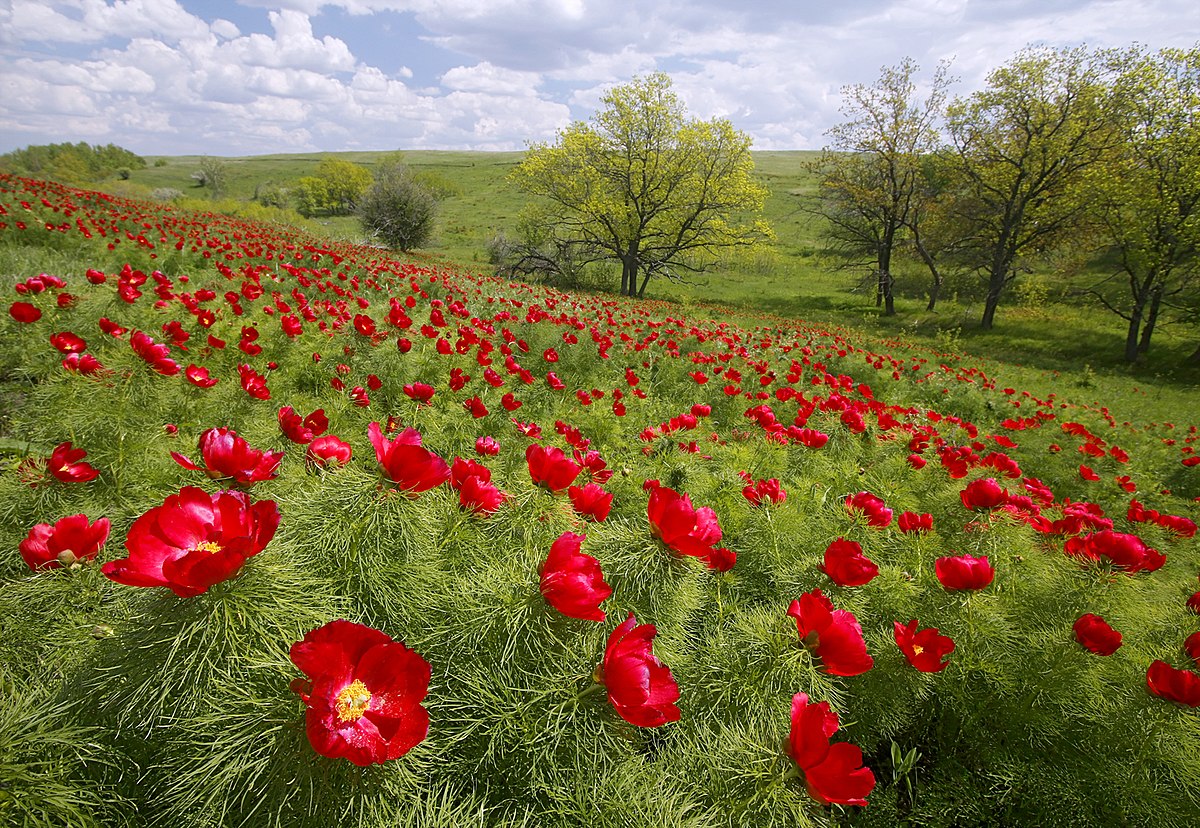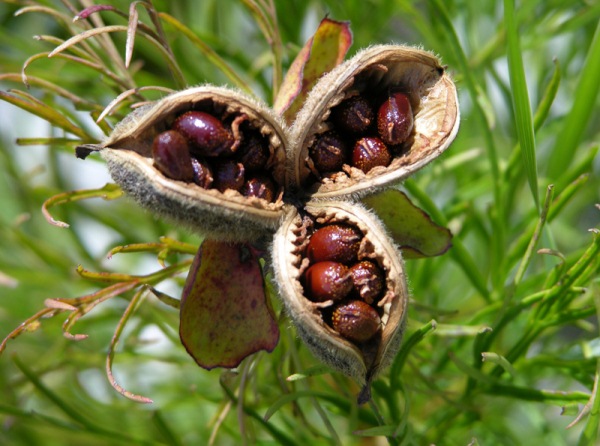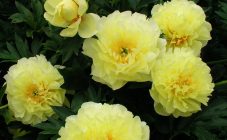Content:
The Thin-leaved peony belongs to the Buttercup family, which is dominated by a different number of species with all sorts of features. The flower has a zest - narrow and long leaves. It has not only an interesting and unique appearance, but also a fragrant aroma.
View characteristic
Due to the narrow leaves, which have a bright green color, this type of peony is also called narrow-leaved. They do not turn yellow for a long time and look spectacular even after the flowers wither. The buds are medium in size, up to 10 cm in diameter. Their color is juicy, bright red, and numerous anthers are of a delicate golden hue.
Flowering begins at the end of May. You can enjoy fragrant, stunningly beautiful flowers for 10 days. More than ten buds are formed on one bush. Plants usually have a rounded shape and grow up to 50 cm. In mid-July, when all the buds have finally bloomed, fruit-boxes are formed in their place, in which there are seeds of a black-brown hue. In early August, the upper part of the bush dries up and only the rhizome remains.
Every year the narrow-leaved peony grows, the number of buds increases, and the flowers become more voluminous.
Thin-leaved peonies and their varieties (Alpine peony, Tiny Tim, Terry Thin-leaved, Merry Meyshine, Voronets and others) are quite unpretentious in care, they can easily survive small frosts and dry summers. But, despite the fact that they can easily cope with any weather conditions, the flowers are listed in the Red Book.
Choosing a landing site
Before planting a shrub on a garden plot, you should take into account some of the nuances of growing it in the open field.
- Soil moisture.
Peonies do not tolerate excess moisture. Only during bud formation and before they should bloom, abundant watering is recommended. But moisture stagnation at the rhizome should be avoided. This can provoke rotting of the root system and lead to the death of the plant.
- Acidity.
Peony Thin-leaved will not take root on acidic soil and may soon die. To prevent this from happening, it is recommended to alkalize the soil: lime, mineral fertilizers, wood ash.
- Illumination of the area.
Before planting, choose a place where there will be plenty of lighting and sunlight. Peonies can live well in shaded areas, but on the sunny side they grow and bloom more abundantly.
- Drafts.
Peonies do not tolerate drafts and strong winds. Therefore, you should take care of the breeding place in advance, where such weather conditions will not be terrible for the plant. These can be: a local area, a far corner of the garden.
- Aesthetics.
Many summer residents care about the aesthetic appearance of their plots. Relying on the fact that the flowering of peonies stops already in July, and by August the bush dries up altogether, it is better to plant this plant between perennial and long-flowering brethren.
Among other flowering plants, the dried up bush of the Thin-leaved peony will be invisible.
Reproduction methods
You can propagate the Thin-leaved peony using:
- dividing the bush;
- sowing seeds;
- root cuttings.
Dividing the peony bush
For the first method, more mature plants from 5 years old are suitable, which can reproduce without problems.
The division is done like this:
- In the fall, the bush is divided into parts. Each division must have at least 2 buds. Ideally, there should be 3-4.
- Dig holes 60 × 80 cm.The distance between them should be at least 1.5 m.
- Fill the bottom of the holes with mineral fertilizers and drainage. The drainage layer should be up to 15 cm and may consist of: small stones, gravel, broken brick.
- Having landed the delenki, they should be sprinkled with earth. The buds should also be buried in the ground to a depth of 2 cm.
- Fertilize with: humus or peat.
After planting, in no case do not compact the soil around the seedlings. The root system of the Thin-leaved peony is quite fragile and tamping can harm it, which in the future can negatively affect the survival of the plant or even lead to its death.
Seed propagation
The second method is not as popular as the first, since it is a laborious process and more time consuming.
You can propagate the plant as follows:
- After the seed pods are fully ripe, they must be carefully collected. This is done in July.
- Wrap the boxes in paper and store in a cold place until mid-autumn.
- In October, take out the containers and remove the seeds.
- Place them on a newspaper and put them away for a month in a dark place, where the air temperature should be at least 15 ° C.
- In mid-November, loosen the soil in a prepared place and sow seeds.
The first shoots should appear with the arrival of spring. But there is a high probability that there may not be seedlings. Therefore, gardeners do not resort to this planting method.
Peony cuttings
The third method is also less popular.
It is carried out as follows:
- In the middle of autumn, when the plant's root system is finally formed, vertical layers are separated from the roots.
- Wells are made, as in the first method, only the distance between them should not exceed 70 cm.
- Plant the layers and insulate the landing sites with straw or spruce branches.
- With the onset of spring, remove the insulation.
You can choose the breeding method to your liking. Given the unpretentiousness of the plant and its widespread prevalence, flower lovers can try all three methods for a short time, and then they will stop at one, the most convenient.
Care rules
Caring for this type of peony is quite simple.
- Mulch the soil.
This prevents weeds and premature drying out of the soil around the bush.
- Watering.
During the dry period, watering must be done at least 3 times a week. But it should be remembered that in no case there was stagnation of water in the root zone.
- Feed.
In September, peonies should be fertilized with potassium-phosphorus mixtures. With the arrival of spring, fertilizing is done with nitrate or urea. But no more than 60 g per 1 bush.
In the third year after planting, fertilization should be carried out depending on the abundance of precipitation. In a hot period - less often, and in a rainy summer - increase.
- Loosen the ground.
This must be done very carefully to avoid injury to the rhizome.
- Rejuvenate.
Rejuvenate peonies by division. As indicated in the first breeding method.
- Remove excess buds.
In the first 2 years after planting, the buds must be removed. This is done for the full growth of the root system.
- Pruning.
Withered leaves need to be removed regularly. They are cut at the root.
- Preparing for the winter.
In cold regions, plants are covered with spruce branches for the winter.
Diseases and pests
There are several insects that can harm peonies - these are:
- Aphid.
- Caterpillar.
- Sod ant.
The infusion of soap with tobacco will help from the first pest.Caterpillars can be easily dealt with with ash or dolomite flour.
Fungal diseases can appear as a result of improper watering. You can cope with this ailment by periodically sprinkling with Bordeaux liquid until complete healing.
In order to further avoid diseases and pests, peonies must be planted away from trees and shrubs.
Beneficial features
This variety belongs to poisonous plants. The poison neonin is contained in the root.
But despite this, it is used in the treatment of:
- With pain in the heart.
- Presence of kidney and bladder stones.
- Concussion.
- Anemia.
- Gout.
- Neuropsychiatric diseases.
- Pulmonary tuberculosis.
It is also used for the preparation of a number of medicines, including:
- Spasmolytic.
- Diuretics.
- Expectorant.
- Bactericidal.
- Protistocidal (against parasites).
- Sedatives.
In addition, it contains:
- tannin;
- anthocyanin;
- flavonoids;
- vitamin C;
- fatty oil.
This is such an incomparable plant that it is used both in landscape design and for decorating a rock garden. Perfect for mixborder.
After reading the description and agricultural technology of this plant, many decide to plant a Thin-leaved peony in their summer cottage. And not in vain, because amateur gardeners and their guests will receive in the future indescribable pleasure from enjoying the wonderful, fragrant aroma and beautiful, spectacular flowers.
